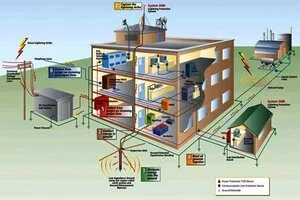Electrical Earthing and Grounding system Training
The process of transferring an instantaneous discharge of electrical energy directly into the ground using a low-resistance wire is known as electrical grounding system. Electrical Grounding system Training is done by connecting the non-current part of the equipment or the neutral conductor of the power system to the ground. Galvanized iron is mostly used for grounding. Grounding provides a simple path to leakage current. The short-circuit current of the device passes to the ground, which has zero potential. It thus protects the system and equipment from damage. Electrical equipment mainly consists of two current-carrying parts.
These parts are neutral to the system or frame of the electrical equipment. From the grounding of these two non-current parts of the electrical system, grounding can be divided into two types. In neutral earthing, the neutral of the system is directly connected to the earth by means of a GI conductor. Neutral grounding is also called grounding system. This type of grounding is usually provided to a system that has a star winding.
For example, neutral earthing is provided in generators, transformers, motors, etc. Such type of earthing is provided to electrical equipment. The non-current part of the device, such as its metal frame, is connected to the ground by means of a conductive wire. If there is any fault in the device, the short circuit current will pass through the ground through the wire. Protect your system from damage.
Importance of Grounding System
The fundamental goal of earthing is to eliminate or reduce the risk of electrocution and fire caused by earth leakage of current down an undesirable channel, as well as to ensure that the potential of a current carrying conductor does not increase higher than its designed insulation with regard to the earth.
When the metallic portions of electrical equipment (parts that can conduct or enable the passage of electric current) come into touch with a live wire, the metal becomes charged and static charge accumulates on it, either due to installation failure or failure in cable insulation. If a person comes into contact with such a charged metal, they will receive a strong shock.
To avoid such incidents, power supply systems and appliance parts must be earthed so that the charge is sent straight to the earth. This is why electrical earthing or grounding is required in electrical installation systems.
Components of Earthing System
Electrical Grounding system consists on the following basic components.
- Earth Continuity Conductor
- Earthing Lead
- Earth Electrode
Why choose us?
Burraq engineering Solutions is an Institute that Provies onsite and online best training progams.
Quality of Training: One of the most important factors that people consider when choosing a training program is the quality of training. They look for training programs that provide the skills and knowledge they need to succeed in their careers or personal goals.
Reputation: The reputation of the training provider is also a significant factor. People prefer to enroll in Grounding system training programs that are reputable and have a proven track record of success.
Flexibility: The flexibility of the Grounding system training program is another important factor. People prefer programs that offer flexible schedules or allow them to study at their own pace.
Cost: The cost of the Grounding system training program is also an important consideration. People look for programs that are affordable and offer good value for money.
- Options available for difficult to Earth geologies and scenarios
- How to properly connect Earthing system electrodes and conductors
- Types of bonds that are acceptable and where to use them
- Resistance-to-Earth testing
- Earthing Theory
- Hot and Cold Site Theory
- Soil Resistivity testing
- Sphere of Influence Theory
- Basics of Earthing system design
- How Earthing Design can ensure human safety in high-voltage environments
- The impact of lightning strikes on Earthing Systems
- The basic principles of the grounding of medium and high voltage electrical systems
- Protective or Safety Earthing systems
- Safe and unsafe working conditions
- Design considerations of an Earthing Mat for medium and high voltage
- Measuring of Earth resistance, the resistivity in substations
- Protection of substations from lightning energy
- Earthing Standards

Electrical Earthing and Grounding system
- Rs 40,000/-
- Course Duration 1 Month
- Online Session
- On Campus Lecture + Practical
- Video Lecture Available
- Urdu & English
- 24/7 Support
- Fee: 40,000
- Duration: 1 Month
- Timing: 9AM-11AM, 11AM-1PM, 1PM-3PM, 3PM-5PM, 5PM-7PM, 7PM-9PM
